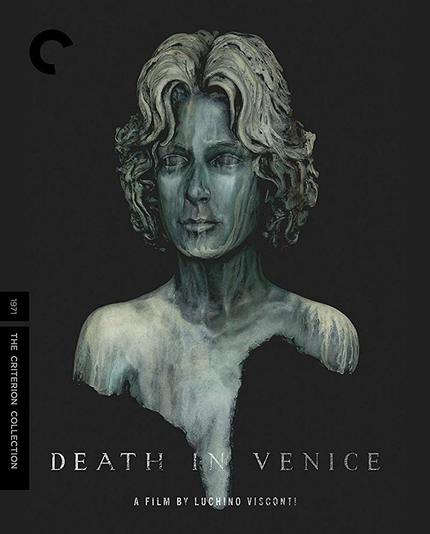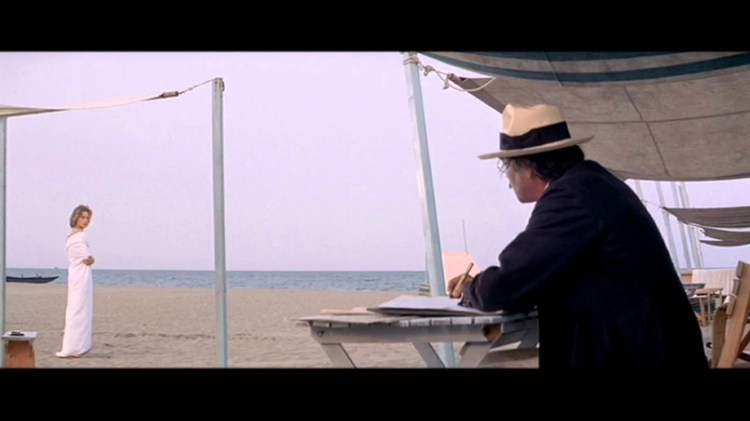Blu-ray Review: Visconti's DEATH IN VENICE Lives in Glorious Anguish on Criterion Blu-ray.
Luchino Visconti adapts the controversial Thomas Mann novella with actor Dirk Bogarde.

Celebrated composer Gustav von Aschenbach (Dirk Bogarde) falls prey to a singular longing of the forbidden variety in Luchino Visconti’s 1971 Death in Venice.
As far as vacations go, this one’s a killer. As far as escapism goes, this film is immaculately lonesome. Out among the unscrubed ancient splendor of Italy’s great water-paved Lido, our irritable and soul-weary protagonist descends ever deeper into his torment. Modulated mostly, Gustav’s temper nevertheless erupts now and then in sideways frustration. Words are scarcely spoken throughout Death in Venice; plot is nonexistent.
In Venice, the waters flow everywhere. As advertised, it mainly streams millions of tourists along the picturesque thoroughfares of the majestic city. But if there’s a dark side to this paradise, that’s the space Gustav occupies. He’s come for revitalization; he gets only hollow-core philosophy and unfulfillable longing. Tormented by personal tragedy, illness, and artistic stagnation, his antagonistic confidant Alfred cuts into him thusly: “Do you know what lies at the bottom of the mainstream? Mediocrity”. Somehow, a dagger.
In the hands of Italian filmmaking master Visconti (Senso, The Leopard), Venice has never before been so gloomy, so chilling. Far from the romantic sun-drenched getaway depicted in every other movie which travels there, Visconti’s Venice is a tired facade, washed out and suffocating. This alone is a bold, unique rendering, revealing one of the most majestic places places on Earth as just another tourist trap, desperate to maintain its vital illusion of perfection and retreat. A Carnival Cruise; a Disney vacation package; just another time share on a ticking clock, circa 1912. Somewhere, far beyond these green and tainted waters (not an exaggeration, as it turns out), the Titanic itself goes down. The deaths of its passengers would be relatively quick and cold, externally inflicted in the dark of night. Gustav’s death in Venice, no less opulent, is otherwise the exact opposite. He is both the tormented soul and the melting witch in the inescapable bad part of Oz.
Based on the renowned 1912 novella by Thomas Mann, Death in Venice is anchored as the middle entry of Visconti’s late-career “German Trilogy” (between 1969’s The Damned and 1973’s Ludwig). While some have taken issue with the filmmaking maestro’s interpretation of Mann’s central struggle- Gustav’s overwhelming attraction to an effervescent pubescent boy (an androgynous Björn Andrésen), also vacationing, with his family- there is no denying Visconti’s purely cinematic mastery of showing rather than telling. In his life before the film, Gustav was a family man; a wife left in the past and a young daughter left in the ground. That this admittedly effeminate boy has now captured his attention is played with few words but a multitude of emotions, each of them colliding, overlapping, ransacking, condemning and igniting this man unawares. He is helpless, guilty, and tortured, alone to literally sweat it out on the beaches and in the parlors and the dining halls. In his mind, he’s seen perfection incarnate- and therefore there’s no beating this thing. Being that nothing tangible ever happens between Gustav and the boy, nor anyone else, Death in Venice is perhaps the most uncomfortably adult themed film that censor boards, left with no targetable moments or dialogue, were resigned to assigning all-ages ratings.
There are those who quibble with the casting of Bogarde as Gustav, claiming he’s unconvincingly as a composer, or whatever. That Visconti, the famously homosexual communist and former aristocrat of film history, ever so rapt in his own meticulous doings, changed the character from a writer to a composer might be part of the issue, who knows. But what Bogarde does sell, completely and boldly, is the withering inner dry rot of this individual. In those days of just over one hundred years ago, even proper, openly gay culture was nonexistent, much less today’s popular notions of gay pride. That’s to say nothing of the pederast angle, a never acceptable horror. Hence, we have a man -- an Important man -- blindsided with no way of navigating this. Gaseous drawing room discussions of the nature of Art and the Truth of the creative impulse only get Gustav- and us- so far. There’s something rotten in Venice, and it’s roughly 185 pounds of flesh, bound in dapper layers of fine wardrobe offerings, nose spectacles, and a fedora to match. Anuric failure of the soul.
For this tale wrought with lost luggage and misplaced expectations, Criterion truly delivers the goods. Their new Blu-ray release of Death in Venice, a new 4K restoration of the film, arrives with a wealthy man’s trove of bonus features, both vintage and newly minted. Top among them is the nearly one-hour documentary by Carlo Lizzani, Luchino Visconti: Life as in a Romance. Though credited as a 2008 production, this comprehensive piece looks quite a bit older than that. It features later interviews with actors Burt Lancaster, Silvana Mangano, and Marcello Mastroianni, as well as filmmakers Francesco Rosi and Franco Zeffirelli; spanning every film and major operatic production. Then there’s Alla ricerca di Tadzio, a thirty minute program from 1970 detailing Visconti's multi-national efforts to cast the role of the boy.
Stefano Albertini, a literature and cinema scholar, appears in a featurette to compare Mann’ novella and Visconti’s film; there’s a 2006 interview with Death in Venice costume designer Piero Tosi; an excerpt from a 1990 program about the music in Visconti's films, featuring Bogarde and actor Marisa Berenson; a 1971 television broadcast in which Visconti discusses the film; Visconti's Venice, a short 1970 behind-the-scenes documentary featuring Visconti and Bogarde; and the film’s trailer. The printed essay included in this starkly handsome package is by critic Dennis Lim, and it is a good one indeed. All in all, Criterion has presented Visconti’s luxury class ticket to Hell in a truly first class package.
Death in Venice is, in its own way, an immaculately overwhelming movie, the kind that sticks hard to the inside of your skull in both striking and unsettling ways. It slowly drifts in on the haunting strains of the extensively utilized Third and Fifth Symphonies of Gustav Mahler, the composer that’s said to have inspired Mann in the first place. It’s true that Visconti is moving at a very deliberate pace, though one that feels entirely appropriate in every way for the story being told. At 131 minutes, Death in Venice is still among Visconti’s shortest films of the lavish second half of his career. It is a grand meditation that invites empathy but not necessarily sympathy; it is uniquely compelling, with its garish beauty and strange affinity for the zoom lens. Visconti, like Mann, stops short of asking viewers to root for the man and the boy to get together. That, thankfully, is entirely not the point. The point is to show the blunt, raw truth of what it is to wake up to the realization that one has honestly already lost everything.
Death in Venice
Director(s)
- Luchino Visconti
Writer(s)
- Thomas Mann (novel)
- Luchino Visconti (screenplay)
- Nicola Badalucco (screenplay)
Cast
- Dirk Bogarde
- Romolo Valli
- Mark Burns
- Nora Ricci








